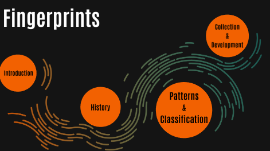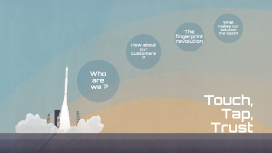Fingerprint
Transcript: Fingerprints Fingerprints Introduction The reproduction of patterns of the friction ridges on the distal phalanges of the fingers & thumbs are called as "fingerprints". The science of identification through the examination of fingerprints is known as "Dactyloscopy". Prior to fingerprint The first systematic attempt at personal identification was devised and introduced by a French Police Expert, Alphonse Bertillon in 1883. Bertillon System was based on eleven measurements of human body in metric system for recoding data. Fall of Bertillon’s System (The West Case) The Method receive its most severe & notable set back in 1903 when a convict “Will west” arrived in Fort Leavenworth Prison. A file revealed that another prisoner named as “ William West” have the same bodily measurements & photographs too. Subsequently, Fingerprints of both prisoners clearly distinguished one from another. Importance The Fingerprints as evidence are important because : 1 2 3 4 5 They are unique. They are permanent . They are universal. They are inimitable. They are classifiable. Nature Nature The palmar surface and the plantar surface are covered by a layer of corrugated skin,the elevated surface are known as papillary or friction ridges while the valleys formed between two ridges are known as furrows grooves. The ridges have small pore, which exude perspiration which is secretion of the eggrine gland. Principles Principles The ridges formed even before birth do not change until & unless destroyed by decomposition after death. Two fingerprints are identical only if they are both produced by the same finger of the same person. Permanency Individuality Terminology Terminology Minutiae or Galton’s details : The ridges are characterized by minute peculiarities such as ridge endings, bifurcations, dots, enclosures, etc. Pattern area : It is that part of loop or whorl in which appears the cores, deltas, & ridges with which we are concerned in classifying. Type lines : Two inner most ridges which start parallel, diverge, & surround or tend to surround the pattern area. Bifurcation : It is the forking or dividing of one line into two or more branches. Focal points : Within the pattern areas of loops & whorls are enclosed the focal points which are used to classify them. These points are called as delta & core. Ridge : The narrow elevated line on the friction skin are called ridges & they are studded with sweat pores. History Humans have been aware of and fascinated by the patterns on their fingers for thousand of years. Use of finger impressions as seals on documents begin as early as third century B.C. History Ancient history Ancient History - 6000 Years Ago: Earthenware bearing clearly discernible friction ridges impressions were found in north-west chine. - Impressions on the clay used to make bricks were found which belongs to neolithic period. - Megalithic artworks in the tomb of Gavrinis on an island just off the west coast of France and in the tomb at Newgrange on the coast of Ireland were also found. 221 B.C. to A.D.1637 221 B.C. to A.D. 1637 - The Chinese were the first culture known to have used friction ridge impressions as a means of identification. - “The Volume of Crime Scene Investigation—Burglary”, from the Qin Dynasty. - Documents(land contracts, wills, and army rosters) consisting of bamboo slips or pages were rolled with string bindings, and the strings were sealed with clay using fingerprints is a prevalent example. - It is believed that the use of prints on important documents was adopted from the Chinese, where it was used generally, but in India it was mainly reserved for royalty. 17th Century 17th Century - 1684 : Friction ridge skin is first described in detail by Dr. Nehemiah Grew. - 1687 : Marcello Malpighi credited with being the first to use microscope to study the fingerprints. 18th Century 18th Century - 1788 : J.C.A. Mayer is the first to write that friction ridge skin is unique. 19th Century 19th Century -1856 to 1897 : Herman Welcker is the first person to start a permanence study; though, credit for being first person to study persistence of the friction ridge skin goes to Sir William James Herschel. 20th Century 20th Century - 1858 : Herschel’s spontaneous printing of man’s hand as proof of identity is first official use of friction ridge skin as a signature by a European. - 1880 : Henry Faulds is the first to publish in a scientific journal the value of friction ridge skin for individualization. - 1883 : Arthur Kollman is first to identify the presence and location of volar pads on the hands & feet. - 1891 : Juan Vucetich’s classification system & individualization of prisoners through the use of fingerprints are the first practical uses of the fingerprint science by law enforcement personnel. - 1892 : Rojas Murder Case, in Buenos Aires, is considered to be the first homicide solved by the fingerprints evidence, & Argentina becomes the first country to rely solely on fingerprints as a method of STRATEGY

















